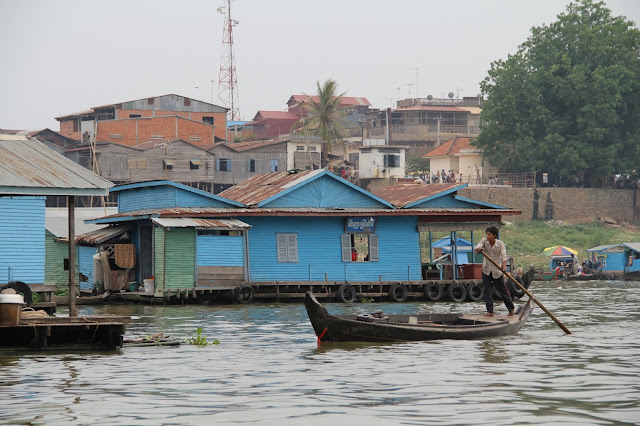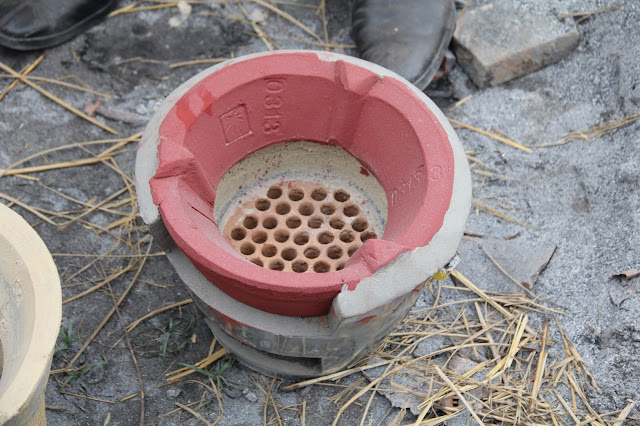10th April
2013
We spent
the night at the wharf in Phnom Penh and few people, if any , took up the
opportunity to back ashore after dinner to have a further look around. Most of
us were just relaxing after a busy day.
We depart
from Phnom Penh at 6 am, to move further up a tributary of the Mekong, the
Tonle Sap river, to the town of Koh Chen. This is on the way to the lake where
Siem Reap is located, but it is currently the dry season and there is
insufficient water in the lake for us to enter. So after our visit up the Tonle
Sap, we will have to retrace our steps back to the main river, to move further
upstream, and ultimately get a bus to Siem Reap.
Whilst
departing from Phnom Penh, we managed to run over a local fishermans net, and
had a brief break to clear it from the propeller, and pay the fisherman US$25
as compensation
Arrival at
Koh Chen (Kampong Luong) was very interesting. A thin rickety jetty had been
built out from the shallow shore, and our captain managed to miraculously edge
our large vessel in next to this jetty without destroying it. A truly
impressive piece of seamanship. We arrived there at around 8.30am.
Koh Chen is
40 km north of Phnom Penh, and the entire community is involved in making
various items from silver (and as we discovered, also copper and brass which is
given a quick dip in silver nitrate for a thin coat of silver).
It is a
very friendly village and all of the families are silversmiths. After the Khmer
Rouge rule, there were only a few families of silversmiths left in Cambodia,
and this village is now the centre of this craft. Everything is hand made and
quite intricate.
The pieces are all hand beaten and patterned with a series of punches
The pieces are all hand beaten and patterned with a series of punches
this large piece has been commissioned by a buyer from Australia
Repairing a broken thong, but not dropping the merchandise
Local chickens eating a mango
After
visiting various families that specialized in different items, and buying a few
trinkets, we all headed back to the ship. It was warm again on shore, but
nowhere near as hot as yesterday. We were back on board by 9.45 am, and
immediately weighed anchor to head further upstream to Kampung Chhnang. By now
the river is getting narrow, and filled with water hyacinth. There would be
little chance of a vessel of our size passing us, so the skipper gave a warning
blast as he approached a few tight bends.
In the meantime, we take in the river
life, there is always something going on either on the water or on the shore.
Kids playing in the water
It is quite
a long trip to Kampong Chhnang, and we arrive at 3pm, drop our anchor, and are
quickly greeted by 2 sampans to take us for a tour through the floating village
and then ashore. The floating village is very large and is mainly Vietnamese
people, who fled south Vietnam during the war, hoping that once they were in
Cambodia, they could apply for refugee status and go to the USA. Of course when
they got there, they found another Communist Government who was never going to
let them go to the USA, so they are still there. They are mainly fisherman,
operating fish farms similar to those we saw in Vietnam.
Once ashore
we are shuffled into mini buses for a 20 minute trip to Andaung Russey village.
The trip through the main town , through the market area, and eventually out
into the country.
Monks crossing the harvested rice paddies just outside the village
We find a cashew tree which still has some fruit left on it
Once at the village, we walk through to an area where palm
juice is collected and made into palm sugar (and wine, or rocket fuel). A
gentleman 61 years old is the local expert and briskly climbs the sugar palms
about 23 times a day to collect the flowers from which they extract juice,
which is then treated and boiled down to concentrate it into palm sugar (widely
used in Asian cooking).
We get a full demonstration of him climbing a tree and
going from tree to tree about 50 foot off the ground before returning with some
juice in bamboo containers. We also had
the pleasure of tasting the “wine” he makes (distills) from the fermented
juice. It is about 40% alcohol, and you could run your car on it. Our German
visitors are impressed and buy a few bottles.
The Germans like the wine
Male and female flowers from the sugar palm, from which the juice is extracted
If allowed to mature, the fruit is bright orange and fibrous inside and smells a bit like mango
Sugar palms look like this and can live for up to 1000 years
The Germans like the wine
After a
very informative presentation on the virtues of sugar palms, we head off to see
a local pottery, where the pots are all hand made without a potters wheel, and
fired in an open fire once enough pieces are ready to fire.
The pot is shaped by walking around it
She started with a solid piece of clay and no pottery wheel, first forming a hollow cylinder
The last step is to close off the bottom of the pot
Next is a
mini factory producing charcoal stoves, using a design developed by an
International Aid Group, dedicated to reducing the destruction of forests for
firewood and offering a practical energy efficient solution for the locals. It is an upgrade of the old charcoal cooker
which is common throughout Asia, with addition of an outer metal casing which
incorporates insulation between the casing and the cooker, using ash from
burning rice husks as insulation.
The core of the stove is moulded and fired
The core of the stove is moulded and fired
The finished product
Our guide explaining the process (the pile of material is the rice husk ash insulation)
It has been
an interesting afternoon and well worth the trip up here. We now catch the
sampans back to the ship, so she can get under way to head back to the main
river and we will again anchor not far from Phnom Penh for the night.
Joy had decided to give the excursion a miss and stay on the ship to rest. This photo captured her 'resting" with a fellow passenger at the stern of the ship as we approached in our sampan
Joy had decided to give the excursion a miss and stay on the ship to rest. This photo captured her 'resting" with a fellow passenger at the stern of the ship as we approached in our sampan


































No comments:
Post a Comment